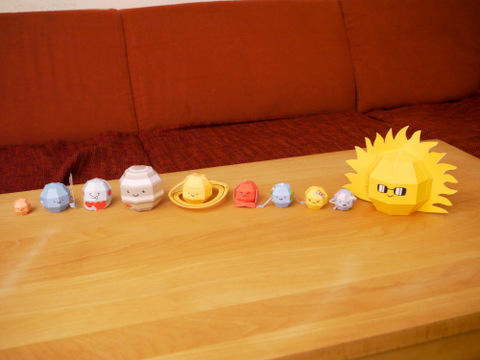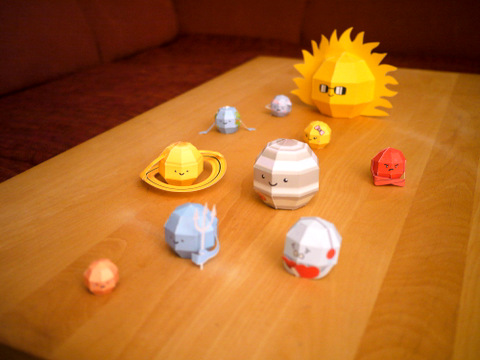- Thumbnail
-

- Resources
- Received from the internet.
- Author
- Unknown.
- Printed File Format
- Page(s)
- 10
- Instruction Format
Solar System papercraft
There are an unknown number of smaller dwarf planets and innumerable small Solar System bodies orbiting the Sun. Six of the major planets, the six largest possible dwarf planets, and many of the smaller bodies are orbited by natural satellites, commonly called "moons" after Earth's Moon. Two natural satellites, Jupiter's moon Ganymede and Saturn's moon Titan, are larger but not more massive than Mercury, the smallest terrestrial planet, and Jupiter's moon Callisto is nearly as large. Each of the giant planets and some smaller bodies are encircled by planetary rings of ice, dust and moonlets. The asteroid belt, which lies between the orbits of Mars and Jupiter, contains objects composed of rock, metal and ice. Beyond Neptune's orbit lie the Kuiper belt and scattered disc, which are populations of objects composed mostly of ice and rock.

There are an unknown number of smaller dwarf planets and innumerable small Solar System bodies orbiting the Sun. Six of the major planets, the six largest possible dwarf planets, and many of the smaller bodies are orbited by natural satellites, commonly called "moons" after Earth's Moon. Two natural satellites, Jupiter's moon Ganymede and Saturn's moon Titan, are larger but not more massive than Mercury, the smallest terrestrial planet, and Jupiter's moon Callisto is nearly as large. Each of the giant planets and some smaller bodies are encircled by planetary rings of ice, dust and moonlets. The asteroid belt, which lies between the orbits of Mars and Jupiter, contains objects composed of rock, metal and ice. Beyond Neptune's orbit lie the Kuiper belt and scattered disc, which are populations of objects composed mostly of ice and rock.

Sponsored: Google Advertising
